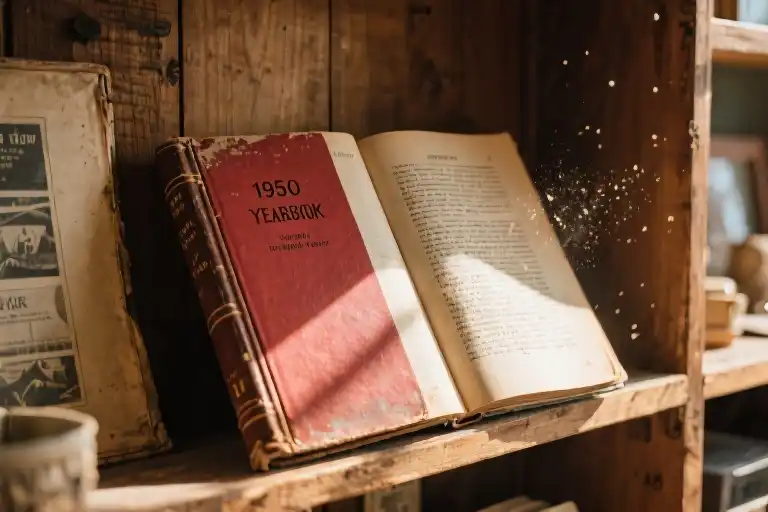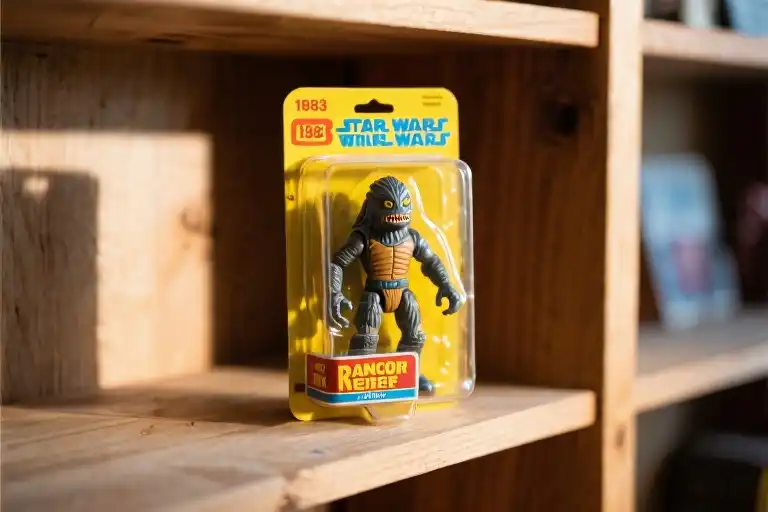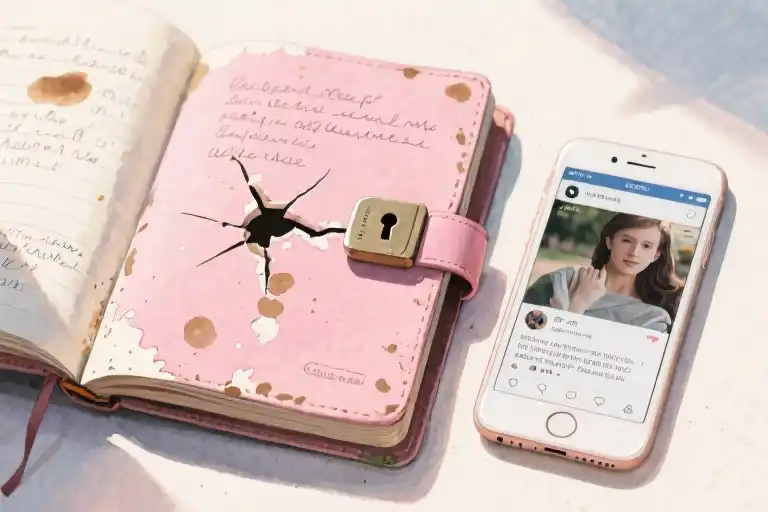The antique shop smelled of aged paper and forgotten stories that afternoon. Sunlight streamed through the front window, illuminating dust particles that danced like tiny time travelers between the shelves. My fingers trailed absently across spines of leather-bound diaries and souvenir plates when something caught my eye – a flash of crimson peeking from the bottom shelf.
Kneeling on the creaky wooden floor, I pulled out the worn yearbook with its frayed cloth cover. The moment my fingertips touched the embossed lettering, an unexpected tremor ran through my hands. This wasn’t just any discarded memento; the book seemed to pulse with silent stories, waiting decades for this exact encounter.
Faint golden letters spelled out “Washington High 1959” beneath my thumb, the gilt worn away in patches where countless hands had opened it before mine. The spine cracked softly as I turned the first page, releasing a scent that was equal parts vanilla and melancholy – the distinctive perfume of yellowing paper and dried ink. Someone named Nancy had once held this book with pride, her name inscribed in careful cursive on the flyleaf.
In that quiet corner of the shop, surrounded by other abandoned treasures, I felt the peculiar weight of holding someone else’s memories. The black-and-white photographs showed teenagers who carried themselves with a formality foreign to today’s youth – boys in crisp suits, girls in sweater sets and pearls, all framed by those thick, dark-rimmed glasses that marked their era. Their smiles held the unselfconscious hope of a generation that hadn’t yet witnessed the turbulent sixties.
As I turned another page, a loose photograph fluttered to the floor – a candid shot of a laughing girl caught mid-spin, her full skirt billowing. Nancy, perhaps? The image triggered an unexpected tightness in my chest, that particular nostalgia we reserve for moments we never actually lived. My mind flashed to the cardboard boxes in my garage back home, where my father’s own yearbooks lay buried beneath tax documents and old tools, their pages holding equally frozen moments from his youth.
There’s something profoundly human about how we preserve these fragments of time, how a simple object can become a vessel for so much unspoken emotion. That dusty yearbook, waiting patiently on a bottom shelf for sixty years, suddenly didn’t seem old at all – just temporarily misplaced between one keeper and the next.
The Archaeology of Memory
The crimson lettering had faded to pale pink where fingertips had brushed across the cover too many times. Nancy 1959 – the gilt imprint now more suggestion than declaration, its edges softened by six decades of quiet existence. As I traced the embossed letters, a fleck of gold came away on my thumb, leaving the N slightly more diminished than before.
This tactile moment transported me to another garage, another time. My father’s meticulous handwriting in the margin of his 1983 yearbook: Purchased May 15 – $12.50. That penciled notation, still sharp after forty years, spoke of his accountant’s precision. Where Nancy’s yearbook bore the marks of frequent handling, Dad’s showed the paradoxical preservation of something both treasured and rarely touched – wrapped in yellowing tissue, then sealed in a Ziploc bag with three silica gel packets.
Two Approaches to Preservation
Nancy’s yearbook lived its life:
- Spine cracked at the senior portrait section
- Corners rounded from being slipped into satchels
- Mystery coffee ring on the faculty page
Dad’s yearbook was prepared for eternity:
- Archival plastic sleeve (still intact)
- Every signature page interleaved with acid-free paper
- Never shelved without cedar blocks nearby
This contrast between organic aging and deliberate conservation made me wonder: which approach better serves memory? The yearbook that lived in hands and backpacks accumulated stories in its wear patterns. The pristine volume maintained factual integrity but perhaps lost emotional patina.
The Weight of Small Things
Opening Nancy’s yearbook released the scent of mimeograph ink and Woolworth’s perfume counter – a sensory portal to Eisenhower’s America. The brittle pages whispered as I turned them, each crinkle sounding like distant applause from a 1959 pep rally. Meanwhile, Dad’s plastic-shrouded copy would never betray such secrets; his preservation methods had inadvertently mummified the very memories he meant to safeguard.
In the margin of Nancy’s basketball team photo, someone had drawn eyeglasses on the coach – a joke preserved like a mosquito in amber. Dad’s identical team shot showed no such defacement, though I found three carefully preserved ticket stubs from games tucked behind the page. These artifacts represented two philosophies: Nancy’s generation let memories live and change, while Dad’s generation curated them behind museum glass.
The Paradox of Preservation
Modern archival science would approve of Dad’s methods – acid-free materials, climate control, minimal handling. Yet Nancy’s battered volume told richer stories through its very damage:
- The smudged portrait where someone’s thumb had lingered
- The pressed violet crumbling between senior superlatives
- The spine’s particular weakness at the prom spread
As I examined these contrasting artifacts, I realized we face this dilemma with all our memory-keeping. Do we save digital photos in cloud storage where they’ll never fade but might never be seen? Or print them to fill albums that will yellow and curl, but might actually be pulled from shelves by future generations?
The garage and the antique store became mirror images – two endpoints on the spectrum of remembrance. In one, carefully catalogued boxes awaited some imagined future curator. In the other, life-worn objects whispered their stories to anyone who’d pause to listen. Between these extremes lies our daily challenge: how to honor the past without embalming it.
Twin Memory Specimens
The garage smelled of damp concrete and pine sol when I unearthed my father’s 1982 yearbook. Its faux-leather cover had warped at the corners, creating tiny valleys where decades of dust collected. As I brushed my thumb across the embossed school crest, three things struck me simultaneously: the chemical tang of aging adhesive, the way the spine cracked like distant fireworks when opened, and how my father’s basketball team photo mirrored Nancy’s 1959 choir portrait in uncanny ways.
Left Page: The Athletes
My father stood in the second row of his varsity team, third from the left – always the position he chose in group photos, as if following some invisible protocol. Their polyester jerseys shimmered under the gymnasium lights, the fabric so thin I could almost hear the squeak of sneakers on polished wood. Someone had drawn devil horns on the coach’s head with blue ballpoint, a teenage rebellion preserved under laminate. The ink bled slightly over the years, creating a hazy aura around the man’s temples like misplaced holiness.
Right Page: The Choristers
Nancy’s choir wore matching Peter Pan collars that looked starched enough to cut paper. The second-row-left-third girl (Martha J., according to the caption) had her pearl necklace twisted nervously around one finger. A Rorschach blob of fountain pen ink obscured part of her shoulder, perhaps from a signing ceremony gone awry. Their expressions held that particular 1950s formality – smiles present but restrained, as if laughter might crack the photographic emulsion.
The Stain Connection
Both artifacts shared this curious defacement: the second-row-third figures marred by ink. In my father’s case, it was likely my own childhood scribbles during rainy afternoon explorations. But Nancy’s? That stain held intention. The edges feathered outward like frightened fingers, suggesting quick absorption into thirsty paper. I found myself inventing scenarios: a trembling hand knocking over an inkwell during yearbook signing, a deliberate blot to conceal some youthful indiscretion recorded in the margins.
Fabric of Time
Running my fingers over the images revealed texture differences that transcended decades. The basketball team’s jerseys showed pilling where shoulders rubbed together, while the choir’s wool skirts retained visible weave patterns. I could almost feel the coarseness of those postwar fibers against my fingertips – fabrics that predated permanent press, when clothing required ceremony and maintenance. My father’s team wore their casualness like armor; Nancy’s group carried their formality as both burden and pride.
Handwriting Analysis
The inscriptions told parallel stories in divergent dialects. My father’s teammates wrote in the rounded block letters of 1980s teen boys: “Stay cool!” “Don’t change!” Nancy’s peers used Palmer Method cursive with exaggerated flourishes: “Remember always our golden days.” Yet both contained that universal yearbook lexicon – promises of eternal friendship, inside jokes now incomprehensible, signatures trailing off as if the writers vanished mid-thought.
The yearbooks lay open before me like butterfly specimens, their wings pinned for examination. Two moments preserved mid-flight, their colors fading but patterns still discernible to those who know how to look.
The Sociology of Fabric
The crisp black-and-white photograph showed Nancy standing with her classmates at the 1959 senior prom, her wool skirt suit and single strand of pearls catching the light in that particular way mid-century photography preserved so well. The girls all wore variations of this uniform – tailored jackets with nipped waists, circle skirts that swayed just above polished pumps. Their hair curled in identical pageboys, their gloves clutched tiny beaded purses. What struck me wasn’t the formality (expected for the era), but how these working-class teenagers from rural Washington had achieved such sartorial precision. Each pearl necklace likely represented months of saved allowance dollars, each wool blend carefully preserved between wearings with tissue paper.
This discovery sent me digging through my father’s 1982 yearbook, where the contrast couldn’t have been sharper. His prom photo showed boys drowning in polyester leisure suits with lapels like airplane wings, their wide ties patterned with geometric explosions of orange and brown. The girls’ chiffon dresses floated around them like psychedelic clouds. Where Nancy’s generation had invested in natural fibers meant to last decades, my father’s cohort embraced the new petroleum-based fabrics – cheaper, brighter, utterly disposable.
The Fabric of Time
Touching the different pages felt like handling archaeological strata. Nancy’s wool-blend skirt (45% angora, the label would have specified) connected to pre-war sheep farms and local dressmakers. My father’s polyester suit emerged from 1970s oil refineries and Hong Kong assembly lines. Both materials represented cultural revolutions:
- Wool Era: Garments as investments, often handmade or tailored, requiring careful maintenance
- Polyester Revolution: Democratized fashion through mass production but accelerated disposability
I found myself tracing the pilling on Nancy’s photographed cardigan, wondering if she’d darned the elbows herself. In my father’s yearbook, a classmate’s synthetic blend had already begun fraying at the seams in the photo itself – a foreshadowing of how these clothes would disintegrate long before their owners did.
Hidden Messages in Threads
The clothing choices whispered secrets about their worlds. Nancy’s single strand of pearls wasn’t just adornment – it was a teenage girl’s careful mimicry of First Lady Mamie Eisenhower’s signature style, a silent aspiration toward middle-class respectability. The boys’ white dress shirts (stiff with starch in 1959) had relaxed into open collars and disco-ready satin by 1982, mirroring society’s loosening formality.
Most poignant was realizing neither fabric culture survived. The wool mills that supplied Nancy’s town have mostly shuttered, replaced by overseas fast fashion. My father’s polyester suits now seem as dated as medieval armor. Holding both yearbooks, I understood how clothing becomes a time capsule – not just of personal memory, but of forgotten industries, lost skills, and vanished ways of living.
Preservation Paradox
The cruel irony? Nancy’s carefully maintained woolens likely decomposed decades ago in some landfill, while my father’s indestructible polyester abominations still exist somewhere, stubbornly refusing to biodegrade. The very qualities that made natural fibers precious (their vulnerability) ensured their disappearance, while synthetic materials outlasted their cultural relevance.
This revelation changed how I view my own closet. That fast-fashion top bought last season already pilling? Future archaeologists will date our era by its sad, shedding fibers. Perhaps we need to rediscover Nancy’s mindset – fewer, better things maintained with care. Not for nostalgia’s sake, but because some fabrics, like memories, deserve to be woven to last.
The Cryptography of Ink Traces
The handwritten inscription in Nancy’s yearbook caught my attention like a faded whisper from the past. “Forever yours,” it declared in looping cursive, the pen’s pressure varying like a cardiogram of teenage emotions—light and fluttery at the beginning, deepening with conviction at “yours,” then trailing off into a wistful dot. This wasn’t just ink on paper; it was fossilized vulnerability.
The Language of Pressure
Forensic document examiners would call these variations “pen pressure patterns,” but to me they revealed something more intimate. The way the downstrokes darkened suggested the writer paused to gather courage mid-sentence. That slight smudge near the edge? Perhaps a hastily wiped tear, or the writer pulling away as someone entered the room. Unlike today’s uniform ballpoint pens, the 1950s steel nib pens Nancy’s classmate used recorded emotional cadence in iron gall ink’s rhythmic flow.
In my father’s 1982 yearbook, I found a different kind of secret. Beneath a classmate’s jotted phone number, faint graphite ghosts showed where digits had been erased and rewritten—not once, but three times. Those shaky corrections mapped adolescent uncertainty as clearly as Nancy’s bold declaration captured hopeful permanence.
Time’s Corrosive Touch
The chemistry of memory preservation became startlingly visible when comparing these artifacts. Nancy’s iron gall ink inscriptions (a mix of tannic acid and iron sulfate) had chemically bonded with the paper fibers, darkening over decades into sepia permanence. Meanwhile, my father’s 1980s classmates used the then-new ballpoint pens whose oil-based inks sat atop the paper like foreign bodies, some already lifting away in brittle flakes.
This explained why Nancy’s yearbook signatures felt like carved epitaphs while Dad’s resembled fading echoes. Modern archivists would confirm: the very ink that made mid-century writing feel eternal—with its slight bite into paper fibers—actually accelerates paper degradation through acidic reactions. There’s poetry in that paradox; the marks meant to endure longest ultimately hasten their host’s demise.
Interpreting the Silences
Between Nancy’s confidently penned messages and my father’s corrected contacts lay unspoken generational shifts. The 1950s signatures often included home addresses—unthinkable today—with looping flourishes suggesting unhurried practice. Dad’s peers defaulted to phone numbers, their numerals leaning anxiously forward like commuters late for the next thing.
Most poignant were the blank spaces. Nancy’s yearbook had two pristine pages labeled “Autographs”—a custom requiring physical presence. Dad’s contained a half-empty “Friends Keep in Touch” section with smudged pencil notes about summer jobs and college plans. The empty spaces between signatures in both books spoke louder than the ink; they were the negative space of lost connections.
Preservation Paradoxes
Handling these fragile pages, I realized we’ve traded permanence for convenience. Nancy’s classmates used corrosive ink that outlasted them, while our smudge-proof gel pens leave marks a damp thumb could erase. We photograph moments in pixel-perfect detail yet store them on failing hard drives. Maybe that’s why vintage items carry such emotional weight—they embody durability in our disposable age.
As I closed both yearbooks, a practical revelation emerged: to preserve today’s memories for future finders, we might need to return to older technologies. Acid-free paper. Pigment-based inks. The physicality that makes digital natives roll their eyes. Because sixty years from now, someone might need your ink’s testimony to understand how we loved, hesitated, and hoped—just like Nancy and my father before us.
The Quiet Return
The yearbook felt heavier in my hands now, as if the weight of all those years had seeped into its pages during our brief acquaintance. My thumb brushed against the frayed corner where Nancy’s name had faded into the maroon cover, the gold embossing now just a ghost of its former self.
I hesitated before placing it back on the shelf – not where I’d found it, but deliberately offset by about thirty centimeters. This small act of rearrangement felt like leaving a breadcrumb for the next curious soul, creating a barely perceptible disturbance in the antique store’s careful curation of forgotten objects.
As I turned to leave, the glass-paned door’s bell chimed with that particular resonance only antique shop entrances seem to possess. For one disorienting moment, the sound transformed in my mind – the metallic ping becoming the shrill ring of a 1959 classroom bell, calling students to attention. The illusion lasted just long enough for me to glance back at the shelf, half-expecting to see Nancy reaching for her yearbook.
What stopped me was the accidental discovery as I’d closed the cover moments earlier – the nearly invisible pocket glued inside the back cover, designed to hold a library checkout card. Empty now, of course, but its very existence spoke volumes about how differently we once treated objects meant to last. That slender pocket, waiting six decades for fingers that would never come to retrieve a card that would never be stamped again, seemed to encapsulate the entire bittersweet encounter.
Before the spell could fully break, I took a mental photograph of three things: the yearbook’s new position on the shelf, the angle of afternoon light falling across its spine, and that vacant library pocket. These details would become the time capsule of my own making, preserving not Nancy’s memory, but the quiet moment when our timelines briefly intersected.
Perhaps this is how objects like yearbooks endure – not through grand gestures, but through these small, almost accidental acts of attention. The way we handle them with slightly more care than necessary, or notice details no one else would pause to see. In that empty card pocket, I saw the inverse of my father’s garage boxes – both waiting, but one having been waited with.
As the door closed behind me, I made a silent promise to Nancy’s yearbook and to myself: to look more closely at the objects deemed unimportant, to recognize that every discarded thing was once someone’s treasure. And maybe, just maybe, to finally open those boxes in the garage.





